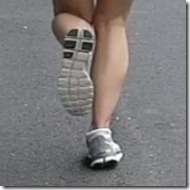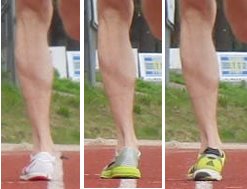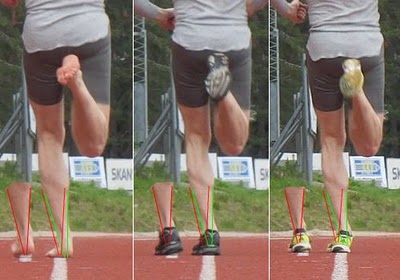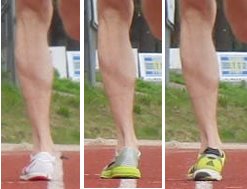 Over the past few years I’ve written several posts on problems with the pronation control/arch height model of fitting running shoes. These include the fact that runners generally have poor knowledge of how much they pronate, that static arch height does not correlate well with dynamic arch height, and that studies have shown little benefit in terms of injury reduction when shoes are assigned based on arch height or pronation control.
Over the past few years I’ve written several posts on problems with the pronation control/arch height model of fitting running shoes. These include the fact that runners generally have poor knowledge of how much they pronate, that static arch height does not correlate well with dynamic arch height, and that studies have shown little benefit in terms of injury reduction when shoes are assigned based on arch height or pronation control.
Several commenters on these posts have indicated that maybe it’s time to move away from stability shoes and give neutral shoes a try. I thought I’d share a few thoughts on this as I don’t necessarily think this is the way to approach things when it comes to running footwear.
Do Pronation-Control Categories Mean Anything?
One of the biggest problems with making neutral a goal is that it assumes that “stability” and “neutral” are actual categories with well defined limits and precise meaning. I don’t believe this to be the case. As far as I’m aware, and correct me if I’m wrong, there are not hard criteria a shoe must meet in order to be classified as a stability or a neutral shoe. It seems that a medial post or some other type of pronation control “technology” is all that’s needed to make a shoe fall into the stability category.
Having run in a lot of shoes over the past few years (I’ve lost count, but wouldn’t be surprised if it’s over 75 now), I’ve rarely found the stability/neutral categorizations to be very helpful – I run in both with little issue. In fact, I’ve run recently in both the Saucony Guide 5 (stability) and Ride 5 (neutral) and I’ll be darned if I could tell you which is which if I put them on with my eyes closed. I’ve even run in neutral shoes with firm soles that almost feel too stable (e.g., many adidas shoes such as the adios 2 and Feather 2).
I think the reality is that there’s way more to making a shoe “stable” than just throwing a medial post on it (and it’s even debatable how effective posts are – gait expert and PT Jay Dicharry once told me that it’s one of the least effective methods of improving shoe stability since the foot pronates most after the post has left the ground during stance). If we define stability as a shoe that minimizes inward roll of the foot (what we runners colloquially refer to as pronation), I personally find that stability is mainly a function of cushioning firmness (firmer = more stable), cushioning amount (thinner sole = more stable), and shoe width (narrow shoes make me feel less stable). I also find torsional (twisting) flexibility to be important – stiff shoes with thick soles feel very slappy to me and I suspect they increase pronation velocity.
Another problem with making “neutral” a goal to strive for is that I don’t really know what neutral as a category means (or that neutral has any meaning for the foot either – read this post by Ian Griffiths for more on this). Some neutral shoes are so soft that they cave medially and cause the foot to pronate way more than it ever would when barefoot (like my wife’s foot in the Nike Free 5.0 at the top of this page; see also this post which hones in on this aspect of neutral shoes). Some are so firm that they feel more stable than a lot of “stability” shoes. The New Balance MT110 is a neutral trail shoe, but because the sole in my pair is so slanted from lateral to medial I can feel it forcing my foot to evert just standing in them – they gave me a case of posterior tibial tendinitis after a long trail run.
Look at the photos below for an example of how three “neutral” shoes can behave differently on the same person – this demonstrates well the lack of a standard response within a category:

adidas adizero Adios 1 (right) with high and narrow sole rolls over medially. Nike Lunar Racer (middle) with wide sole is more stable, and Asics Piranha (left) with lower profile has less tendency to tilt.
Here’s the same person showing foot movement barefoot and in stability and neutral shoes – the neutral shoe appears to cause a lot more inward roll than when he is barefoot:

Does Shoe Motion Correlate With Foot Motion?
An entirely separate issue is the fact that how a shoe moves may have little correlation with how the foot moves inside the shoe. For example, here is the Abstract of a classic 2000 paper by Alex Stacoff that tried to differentiate shoe movement from the actual movement of the foot inside the shoe by inserting pins into the foot and leg bones:
Abstract
Barefoot running kinematics has been described to vary considerably from shod running. However, previous investigations were typically based on externally mounted shoe and/or skin markers, which have been shown to overestimate skeletal movements. Thus, the purpose of this study was to compare calcaneal and tibial movements of barefoot versus shod running using skeletal markers. Intracortical bone pins with reflective marker triads were inserted under standard local anesthetic into the calcaneus and tibia of five healthy male subjects. The subjects ran barefoot, with a normal shoe, with three shoe soles and two orthotic modifications. The three-dimensional tibiocalcaneal rotations were determined using a joint coordinate system approach. Test variables were defined for eversion and tibial rotation. The results showed that the differences in bone movements between barefoot and shod running were small and unsystematic (mean effects being less than 2°) compared with the differences between the subjects (up to 10°). However, differences may occur during midstance when extreme shoe modifications (i.e. posterior orthosis) are used. It is concluded that calcaneal and tibial movement patterns do not differ substantially between barefoot and shod running, and that the effects of these interventions are subject specific. The result of this in vivo study contrasts with previous investigations using skin and shoe mounted markers and suggests that these discrepancies may be the result of the overestimation with externally mounted markers.
The point made by this study is that the movement we see when looking at the shoe from behind may not actually reveal much about how the foot inside the shoe is moving. In other words, a stability shoe may look like it keeps the foot in a more “neutral” position, but the foot may simply be pronating inside the shoe just as much as it would when barefoot.
The Origin of Pronation Control
Another thing to consider is why pronation control devices in shoes were developed in the first place – was the original goal to correct a problem with our feet? I’m not so sure…
The footwear trend in the 1970’s was to add additional cushioning to shoes, particularly under the heel. The reason for this was that Achilles tendon problems were among the most commonly reported injuries in the early 70’s, and lifting the heel was thought to reduce strain on the Achilles. I have also heard that adding cushion was also done to accommodate a changing demographic of runners (new to the sport, perhaps not as fit) – read this book excerpt for more on running injuries/shoes in the 1970’s. However, adding cushion seemed to have some side effects. The late 1970’s saw a decrease in Achilles problems, but a dramatic increase in knee injuries. The latter were thought to be linked to reduced rearfoot control due to the cushioning added to shoes. Excessive rearfoot movement was linked to excessive internal tibial rotation (i.e., the shin twisting inward), which was in turn thought to contribute to the development of problems at the knee. This gave rise to the addition of pronation control elements in an effort to control the rearfoot and save the knee (knee injuries are still by far the most common running injury).
Benno Nigg, one of the scientists who was heavily involved with the study of shoes during this time period (and is still a major researcher in the shoe world today) has since stated that attempting to control foot motion was a mistake – here’s a snippet from a 2010 Runner’s World article featuring Nigg:
“…In the early 1980s, Nigg was working as a consultant for Nike on its line of tennis shoes. While there, he offered input on the need to add more structure to Air models because the much-lauded Air units created even more instability than traditional foam. “I pushed the cushioning trend as much as anyone,” the broad-shouldered Nigg says in his Swiss accent. “And I take the blame for pronation devices as well.””
So the reality is that pronation control technology seems to have appeared to correct problems caused by the addition of cushion and heel lifts to shoes. It was a new element added to shoes to correct for problems created by another new element. (If you are interested in footwear history from the 1970’s, I highly recommend that you read The Running Shoe Book from 1980 by Peter Cavanagh).
In fact, I don’t get the feeling that the appearance of pronation control had anything to do with correcting an inherent problem with our feet (it was correcting a problem with our shoes!). Unfortunately, it has morphed into that for many runners today who feel that they “need” stability because they are an “overpronator” – in this sense overpronation has come to be treated almost as a pathological condition that needs correction lest you want to endure certain pain and suffering.
How Do You Find the Right Shoe?
What can we make of all of this, and how should runners find the right shoe?
I prefer to think of shoes in much the same way I look at runners – each is an individual with its own properties. I’m not at all a fan of footwear categories because there is no defining set of criteria that can be applied to each category, and no standardization as to just how stable a given shoe is. In a similar manner, I don’t like using “minimalist” to define a specific category as there is such a huge amount of variation in what different people would put into it. Is the Saucony Kinvara minimalist? How about the Altra Instinct? Thus, I don’t find the categories “stability” and “neutral” to be all that informative and basically just ignore them now when choosing shoes for myself.
My general feeling is that unless an individual runner has a specific pathology that has been linked to increased injury risk, they should aim to find a shoe that allows their feet to move as they want to move. Don’t attempt to control foot movement, and don’t wear something that is going to cause the foot to move even more than it would on its own. I do think video analysis can help with this to a degree, but keep in mind that we typically only see how much the shoe moves – it’s much harder to discern how much the foot is moving inside the shoe.
Don’t focus too much on categories, focus more on how individual shoes feel – comfort is good, and specifically comfort while running in a shoe, not while standing in it in a store. Benno Nigg, the scientist mentioned above, stated in an article by Amby Burfoot that “Comfort is not easy to define, but it’s ‘probably the most important variable’ for sport-shoe selection.” I would agree with him – I can usually tell after a single run whether a shoe is going to work for me, and it mainly has to do with knowing how a lot of different shoes feel on my feet. A shoe that feels comfortable on the very first run is generally one that stays in my rotation for the long term. I would also agree that comfort is hard to define, but for me I think it’s mainly just how good a shoe is at letting my body do its thing without getting in the way – a comfortable shoe is one that I barely even notice when I run.
The challenge is helping runners who aren’t shoe reviewers with access to large numbers of shoes figure out their own comfort zone – my feeling is that’s where the human factor comes in. Rely on your shoe-geek friends, knowledgeable and open minded specialty store clerks, and others with extensive shoe and running experience to help you out. One day I hope science will have better answers for us on how best to fit shoes, but I don’t think we’re there yet, and until then it remains more an art and a personal journey. It’s a journey that need not have neutral as its end goal.
















Really nice post, Pete.
We agree completely. We’ve been fitting runners for several years now with the idea that the least amount of shoe one is comfortable in is the right shoe for that runner. The proper shoe for that individual–be it a Mizuno Universe or a Brooks Beast–will feel like it is a part of the foot. It will disappear the most. The intuitive response is almost invariably the correct one. We tend to over-think it far too often.
Great stuff. Thanks again.
I like that phrasing – the best shoe will “disappear” on your foot. That’s exactly how I have felt running marathons in the Kinvara and running my recent half marathon in the Grid Type A5. When you’ve found the right shoe you know it.
—-
Pete Larson’s Web Links:
My book: Tread Lightly – link to ow.ly
Blog: https://runblogger.com
Twitter: link to twitter.com
Facebook: link to facebook.com…
Your experience as a runner comes into play here.
Buy a shoe that is very built up in order to “protect” you and cushion you from the elements and “injury” and instead of the shoe disappearing on your foot, your foot disappears in the shoe.
John – Such a great way to put it! -> “The proper shoe for that individual–be it a Mizuno Universe or a Brooks Beast–will feel like it is a part of the foot. It will disappear the most. The intuitive response is almost invariably the correct one. “
Pete – Another great post… keep ’em coming. Keep up the good work!
First off, a wonderful article!
However the advice to go by feel seems quite unhelpful to me. I’m about to get a new pair of shoes and I can’t decide which pair to get. I can’t even decide what to factor into the decision. On the one hand I’ve tried Kinvara (running on a tread mill in a store) and thought they were very comfortable; on the other I just tried a shoe called Nike Lunarglide 4 and loved it too. And they are quite different. One has a low heel to toe drop and a relatively low stack hight, the other pretty much the opposite.
Up until now I’ve used a par of Mirage and a pair of Adidas Ride (it’s a monster – heavy as hell and probably has all kinds of protection and correction “technologies”). I much prefer the Mirage over the Ride but I’m not sure which is better for my knees which are bothering me periodically. So pronation control, lots of support, soft sole? I don’t know. Right now I’m thinking of going with some middle ground type reasoning: a shoe that has some toe to heel drop but not to much (8ish mm?) and has some support but not a tank of a shoe and a sole that isn’t too thin. This way I might not make the perfect choice, but at least I won’t make the worst possible choice either. I hope.
Making my choice all the more difficult is the fact that it seems like most shoes have outer soles which are perfect if one wants to collect rocks on the run.
It really doesn’t matter if one has shoes that are wonderfully comfortable if half an hour into the run you’ve got a bunch of rocks stuck underneath it.
This sure aint easy.
I ran for a long time in shoes designed to eliminate pronation on the advice (from a running store sales rep) that I over-pronated. The shoes also had lots of cushioning. I struggled with nagging lower leg injuries. Several years later I regularly run in neutral shoes with less drop and lower stack heights with no ill effects. For me the important test is what you refer to as “torsional flexibility” or as I simply call it “the pretzel test”. I have found I can run in a mild stability or neutral shoe, low stack or not (I prefer low shoes) and mid-range drop (4-8mm is my sweet spot). But the pretzel test rules. Too twisty and my feet will end up feeling battered. Don’t get sucked in by the marketing and hype.
Suprising how simple it is to choose a good running shoe, just pick one that feels right and ignore the labels in most cases. Why do people always try to overcomplicate! Still seems a long way to go before a better way of classing running shoes by the manufacturers is developed.
hey pete,
the gait guys just released a shoe fit certification program that is pertinent to this post and think you would find interesting. it’s kind of pricey ($450-ish after you buy all 3 videos and the certification exam) but goes into depth about foot/leg anatomy and mechanics and how to fit the person correctly in their opinion. this is actually level I certification. levels 2 and 3 are to be released later this year for advanced shoe fitting.
i passed the level I certification last week. their methodology focuses on foot types (rearfoot varus, forefoot varus, etc), leg structure, specific muscle strength, and a bit more for shoe fit.
it doesn’t really take pronation (as viewed from behind, like most running stores do) into account when pulling shoes, which i like, but they do recommend stability shoes for certain people (rearfoot valgus, for example). and they do think that “overpronation” can be a contributing factor with some injuries, which i’d think you agree with. it’s just not a bad thing in and of itself obviously.
they are big fans of minimalist shoes, but feel that a person has to “earn” their way into minimalism. that is, you someone with injuries should not get a minimalist shoe hoping to increase the strength of a specific intrinsic muscle deficit because it may just force you to compensate for that weakness in a different way and cause more (or worse) problems than you already have.
their hope is to get it out to running stores so stores are being a bit more consistent in fitting runners. it’s good stuff. i’m not sure how much it will catch on because it is fairly pricey, but i’ve learned a ton in the process and am looking at my customers with a much expanded field of vision nowadays.
anyway, thought i’d inject a few comments into the mix. their podcasts are a bit technical for the average person, but you would love them. free on itunes. search “the gait guys”
eric johnson, managerultramax sportswww.ultramaxsports.comspringfield, mo
Are there any scientific studies proving the efficacy of this method? As in a controlled study showing that it reduces long term injury rates versus the old method or even random selection? If not, what prompted you to spend the money on it? And who are “the gait guys”?
You beat me to it – that was exactly my question. I’d need some evidence suggesting to me that this is better than what we have now before I bought into it.
—-
Pete Larson’s Web Links:
My book: Tread Lightly – link to ow.ly
Blog: https://runblogger.com
Twitter: link to twitter.com
Facebook: link to facebook.com…
Thanks for letting me know Eric. I guess my response would be that I’m not sure I’d be willing to pay that kind of money unless the process has been vetted and proven to be effective. We got into the mess we’re in now by smart people proposing fitting models that were never really proven to be effective, and now that we’ve found out that they aren’t particularly effective, we look back on the last 30 years and have to ask ourselves why we did what we did. The other big problem is that any fitting protocol relies on honesty from the manufacturers that their shoes do what they say they’ll do. So if the protocol calss for stability, do they specify which shoes to choose from.
I can see paying that money to attend a workshop for CEU’s or something like that, but this kind of rubs me the wrong way.
—-
Pete Larson’s Web Links:
My book: Tread Lightly – link to ow.ly
Blog: https://runblogger.com
Twitter: link to twitter.com
Facebook: link to facebook.com…
I agree with you John. Just wear and feel. You’ll know the right shoes for you when you try walking with it for a day. Forget the brand. Go with what your feet feels happy in.
question,
as a runner I’ve worn stability shoes forever. now as a walker can i wear neutral shoes?
thanks,
rod